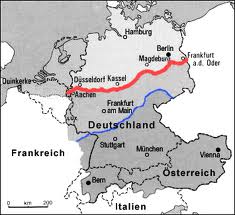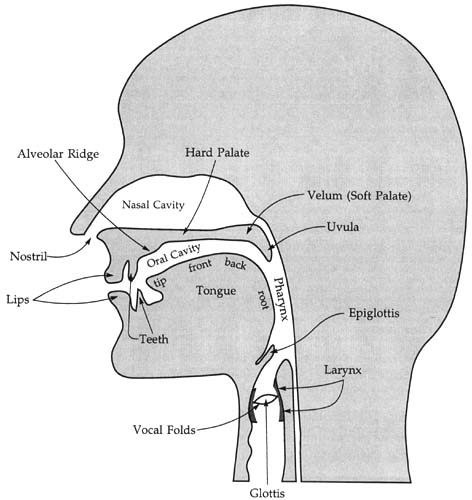After Grimm’s Law, or the First Germanic Sound Shift, the Germanic language family underwent a sound change that affected a range of consonant sounds. This change is known as the Zweite Lautverschiebung (Second Sound Shift) or the High German Sound Shift and split the German area into two main dialect areas.
The sound change probably started in the southernmost parts of the German-speaking land around the fifth century. It gradually restructured the phonetic systems of all of the southern regions and also some of the midland Germanic dialects. There is a clean cut between the dialects in the south that underwent the Second Sound Shift (called High German) and those in the north that didn’t (called Low German). They are named as such because the southern part of the region is highland Germany while the northern part is lowland.
 The Benrath-line (marked red on Fig. 1) divides the two regions. Because the northern dialects did not undergo the sound shift, Low German is much more similar to English. Within High German there is also a subdivision between Middle German (between the red and blue line, Fig 1) and Upper German (below the blue line, Fig.1) based on the extent to which the regions experienced the sound change. The High German Sound Shift affricated the voiceless stops p, t, k and also devoiced the voiced stop d. These changes did not happen all at once, but instead in a chain or a wave. It is most likely that the alveolar stops [t] & [d] were affected first, followed by the labial [p] and last the velar [k]. It is also likely that sounds in the middle of words shifted first and then later sounds at word boundaries underwent the same changes. The sound changes are shown in Figure 2.
The Benrath-line (marked red on Fig. 1) divides the two regions. Because the northern dialects did not undergo the sound shift, Low German is much more similar to English. Within High German there is also a subdivision between Middle German (between the red and blue line, Fig 1) and Upper German (below the blue line, Fig.1) based on the extent to which the regions experienced the sound change. The High German Sound Shift affricated the voiceless stops p, t, k and also devoiced the voiced stop d. These changes did not happen all at once, but instead in a chain or a wave. It is most likely that the alveolar stops [t] & [d] were affected first, followed by the labial [p] and last the velar [k]. It is also likely that sounds in the middle of words shifted first and then later sounds at word boundaries underwent the same changes. The sound changes are shown in Figure 2.
These sounds changes are seen from comparing English and German cognates: Eng. ship ~ HGer. Schiff, Eng. pan ~ HGer. pfanne, Eng. eat ~ HGer. essen, Eng. to ~ HGer. zu, Eng. book ~ HGer. buch, Eng. dream ~ HGer. traum.

One of the more peculiar aspects of the High German Sound Shift is that the voiced stops [b] and [g] are resistant to the change that affects the other voiced stop [d], namely devoicing. If the others were to undergo this same widespread change, we would expect [b] to become [p] and [g] to become [k] in all cases just like [d] became [t]. Instead, [b] > [p] is limited to Upper German and the change [g] > [k] is not complete even in Upper German. If these sounds were driven by the general mechanism in Germanic that spurred the devoicing of traditionally voiceless stops, we would expect [g] to shift to [k] first and most broadly and [b] to shift to [p] after that. This is because it takes more physiological effort to maintain a voiced velar than sounds that are articulated farther forward in the vocal tract like alveolars or labial, due to the small size of the chamber between the velum and the larynx that is able to expand when air is flowing over the vocal folds. In figure 3 you may see the position of each point of articulation: bilabial segments are articulated at the lips, alveolars at the alveolar ridge, and velars at the velum.

Figure 3
Unexpectedly, the change of [g] to [k] is even less common than the change of [b] to [p] in High German, and so there must be something else going on here. One possibility is that the degree to which a sound shift occurs and spreads is based on the markedness of an individual sound segment. By “markedness” I mean the relative complexity of properties that are present in each sound segment — the more complex a sound, the more marked it is. In fact, according to certain scholars, the more place features a segment has, the more resistant it is to change. According to Davis et al. 1999:
- All sounds have place features: [d] is alveolar, [b] is labial, and [g] is velar
- Only [b] and [g] have the feature [peripheral] because they are made at either the front of the mouth ([b]) or the back of the mouth ([g])
- Only [g] has the feature [dorsal] because it is the only sound made using the dorsum of the tongue, labelled as “back” in the figure 3 above.
In terms of these three features, the alveolar stop [d] is the least marked and is therefore the most likely to undergo change. The labial stop [b] is more marked than [d] so it will undergo some change but not as broadly as [d]. Lastly, the velar [g], which is the most representationally complex in terms of these three features, would shift very little if at all. It is for these reasons that the strengthening of Germanic [d] to [t] was most widespread and was found even in the most northern dialects of High German, and why the shift [g] to [k] was much less common, localized only within the most southern dialects of High German. Of course, in order to subscribe to this theory about the Second German Sound Shift you would need to follow Davis, Iverson, and Salmons’ featural theory of these stops, and if you don’t, another explanation would be needed to account for the resistance of [b] and [g] to the Second Sound Shift.
Written by Julia Grzech
For Further Reading:
- Some cognates illustrating Grimm’s Law and the High German sound shift.
- Short history of the German language
- Overview of different dialects in German
- More about Markedness
- http://eweb.furman.edu/~wrogers/phonemes/phono/affric.htm
- https://pantherfile.uwm.edu/iverson/www/periph.pdf
- http://www.ling.ohio-state.edu//~ehume/papers/Companion_markedness(proofs)2011.pdf
- Davis, G.W., Iverson, G.K., Salmons, J.C. 1999. “Peripherality and Markedness in the Spread of the High German Consonant Shift”, Beiträge zur Geschichte der deutschen Sprache und Literatur (PBB), 121(2): 177–200.
- Ohala, John J. 1983. “The Origin of Sound Patterns in Vocal Tract Constraints”, in The Production of Speech, ed. by P. MacNeilage. New York: Springer, pp. 189–216.
- Picard, Marc. 2001. “Vowel harmony, centralization, and peripherality: The case of Pasiego”, Linguistics 39(1): 117-132.
- Priebsch, R., & Collinson, W.E. 1935. The German Language. London: Faber and Faber Limited. p. 111-120
- Waterman, John T. 1966. A History of the German Language. United States: University of Washington Press. p. 56-64.
